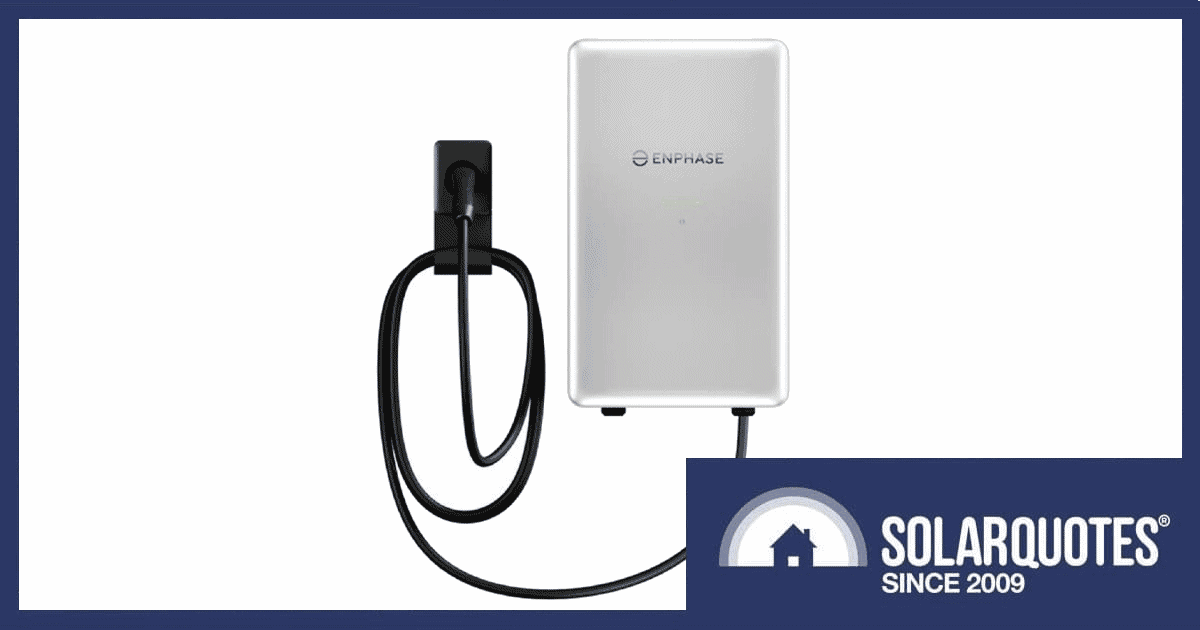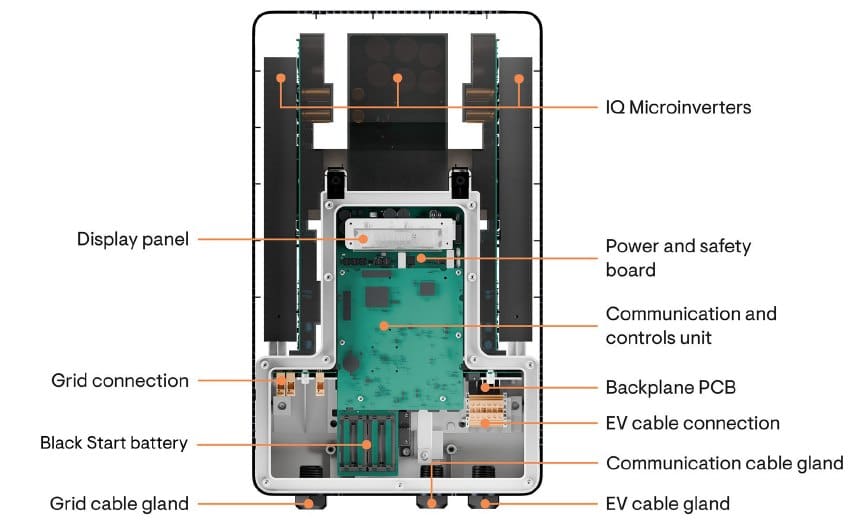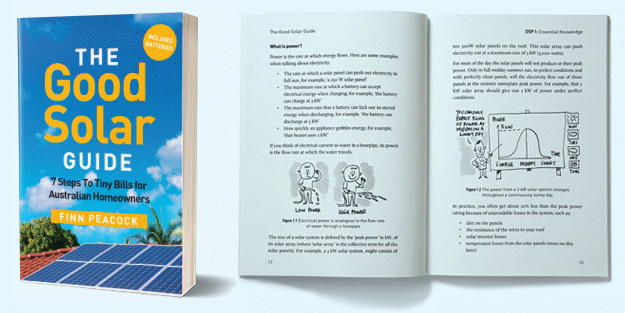
Enphase Energy has taken the wraps off its new IQ Bidirectional EV Charger, a DC device that will offer vehicle-to-home (V2H) and vehicle-to-grid (V2G) support. See what’s under the bonnet.
About The DC IQ Bidirectional EV Charger
When paired with an IQ Meter Collar1, which is a grid islanding device, the bi-directional charger lets homeowners charge their EV, power their home during blackouts (Vehicle to Home – V2H), and export to the grid (Vehicle to Grid – V2G); all managed through the Enphase App. No home battery is needed.
“However, pairing with an IQ Battery enables full system flexibility and backup even when the EV is not plugged in,” states the company.
Features include:
- Up to 11.5 kW of bidirectional power with <1% granular control
- Instantaneous home backup with a “Black Start” auxiliary battery inside the charger to establish communication with the EV.
- Contains three IQ10 EV Microinverters.
- AI-powered energy management.
- Expected to be OCPP 2.1 capable.
- 7.6 metre cable, with CCS1 plug.
- Dynamic load balancing.
- Communication via Bluetooth, Wi-Fi, Ethernet, CAN, and LTE.
- Operating temperature: −30℃ to 55℃.
- Enclosure dimensions: 650 mm × 400 mm × 180 mm.
- Weight: less than 23 kilograms.
- Field-replaceable microinverters, cables, and related parts.
- 10 year warranty.
Enphase says the device will seamlessly transition between EV charging, home backup and grid export based on site conditions, with no manual configuration needed.
“The IQ Bidirectional EV Charger brings the family car into the home energy system,” said Enphase Energy’s Jayant Somani. “It’s simple to install, easy to control, and designed to deliver backup power and the ability to share energy with the grid for homeowners.”
The V2H and V2G features will only work with electric vehicles that support bidirectional power flow.
“It will not enable backup or export modes with non-bidirectional EVs, but standard, high-power DC charging will still function for compatible EVs.”
The Enphase IQ Bidirectional EV Charger should be available in global markets in the latter part of 2026, so there’s quite a wait. Indicative pricing isn’t available as yet, but as this is Enphase, it likely won’t be cheap. But the warranty duration is pretty impressive for an EV charger as most are just a few years.
A full datasheet is available here, but note that’s a preliminary datasheet for North America. There’s also a whitepaper here; again, with a North America focus. The main product page is here.
Enphase IQ EV Charger 2 (AC) Available In Australia
In May this year, we wrote about the Enphase IQ EV Charger 2, which was to offer *AC* bidirectional functionality. This also requires a vehicle that is bidirectional capable; of which there are still few available here.
Enphase originally said the IQ EV Charger 2 was V2X-capable (Vehicle to Everything), but software-locked and further details of these capabilities were vague. The device is now available in Australia, and on announcing its availability here, Enphase said:
“The IQ EV Charger 2 is equipped with built-in hardware and software to support AC bidirectional charging. While availability depends on EV compatibility, standards, and regional certifications, this feature is built to enable vehicle-to-home (V2H) and vehicle-to-grid (V2G) integration – supporting homeowners with resilience and flexibility.”
Back in May, the IQ EV Charger 2 price on the Australian Enphase online store was $2,048, but that pricing has been removed since. There wasn’t any mention if unlocking the bidirectional features involved an extra cost.
While still very new to the Australian market, we’ve set up a customer reviews page for Enphase EV chargers here.
AC Vs. DC Charging
In AC bidirectional charging, the vehicle’s onboard systems handle the two-way power conversion. By contrast, DC bidirectional charging relies on a dedicated DC connection, where the power conversion is managed by external electronics built into the charger rather than the vehicle.
Learn more about AC vs. DC EV Charging.
Is V2G All It’s Cracked Up To Be?
While on the topic, SolarQuotes founder Finn Peacock’s latest post discusses V2G, saying the focus shouldn’t be running cars backwards into the grid, but ensuring as many electric vehicles as possible can charge when the sun is shining.
And if you find all these acronyms confusing, check out our explainer: V2L, V2G, V2H, V2X – WTF?
Related: Home EV chargers compared side-by-side.
Footnotes
- I’m not sure if the meter collar is available/permitted in Australia as yet. I haven’t seen it advertised here; but in the USA it costs around AU$ 880. ↩


 RSS - Posts
RSS - Posts



One would assume that at some point in the distant future, the “hybrid inverter” you get with your standard solar setup is going to feature all these functions as standard.
I hope you are wrong about the “pay to unlock features” possibility. You pay for something it should be fully functional without having to put your hand in your pocket again. Mind you there would probably be some hacker dwelling in his mothers basement somewhere who fixes that issue for us soon enough.
“Operating voltage range (AC), max. current (A) at 240 V:
240 VAC ±15%, 48 A single-phase/split-phase”
Split Phase is American talk for 2 phase 110V, right?
My recollection is that the American 110V split phase is a centre-tap on the pole transformer, so the two circuits are 180 deg out of phase, not 120 deg. The full winding provides 220V.
Yes but, yes but ,… which energy retailers in Australia will or have adopted this ?
I think home batteries are an interim stage of grid transformation. If you look at the amount home batteries can store each day and their predicted life, I think they are still uneconomical.
Whilst I have had solar panels since 2010, my next move will be when I can use an EV to power my home and provide transportation. Once bi directional chargers are widely available and affordable, that is the way to go. Car batteries offer several times the capacity of a home battery, which could easily be used up by an average household in a few hours .
Brenton, in reality, the EV battery is sometimes smaller than the house battery, as in my brother’s case. My MG4 has 51 kWh, the house 46 kWh, so about the same. For us V2H is a stillborn fad which never made it – killed by falling battery prices causing larger stationary battery installations, much more conveniently usable, especially without losing mobility.
Finn’s blog reminds us of V2G’s lack of utility – the EV’s often not home to be charged during the day (but the house battery is), so there’s little or nothing to V2H during the evening peak. What’s in the EV is needed to get to work tomorrow. That can’t readily be fixed by technology – other than riding a bike to work, to make the EV a stationary battery.
A mate up the road is installing an 80 kWh battery in his new off-grid build. No plan for V2H there, and no takers that I’ve personally spoken to, either.
A big battery does many less cycles. Mine will see 20 yr calendar life limit long before cycle life hits.
Good luck!
What you say is right for some people. Especially if you are financially comfortable. However, for many of us less financial, the cost of an EV plus a home battery is very high. Even more so for retired people who don’t drive very much.
It’s true that *sometimes* the EV battery is smaller than the house battery, but surely this is the exception. My BYD has 60 kWh, and I wouldn’t consider getting more than half that in home battery storage. Battery prices may be falling, but cars with 60kWh that are well priced (esp through Novated Leasing) and can save $2000 in petrol costs per year make them much more functional way to own sizable batteries for many.
In terms of V2G utility – our EV *is* often home to be charged during the day (WFH days + PT to work), so there would be plenty to V2H/G during the evening peak. And that’s likely true for many.
I think people purchasing 40-50k cars, with large batteries that can both save car costs *and* home energy costs is more of a winner than people paying half or 3/4 that amount for a massive home battery.
I agree, and I’ve been waiting five years already to be able to use an EV to both charge and supply with my 10kw solar system — but of course in the meantime to get any benefit from daytime solar for my home I had to install fixed home batteries. 20kw Lipo runs my home at night includng ducted air con/heat. But I sure wanted to do the ‘buy a phev (who knew that hev was going to overtake phev, not me) get a free home battery included with it’. Australia wasn’t ready.
With the shortage of vehicles with V2H functionality, that are available in Australia, and, the lack of incentive from the feral government, for them to be made available in Australia (why does the inclusion of stationary behind the meter batteries, in the SRES scheme, not include BEV’s with V2H functionality and/or V2L functionality with capacity of at least 3.6kW?), I am wondering at the feasibility (I think that is the word that is closest to an adjective form of the noun “worthwhile”) of getting a “bi-directional charger” – a bi-directional transferer of energy at the V2H level, when the HOEM devices are available, and, a number of BEV vehicle models are available, that have V2L capacity of 3.6kW. To me, it seems more worthwhile, to get a 15A HOEM device, and a 15A A/C power outlet to provide 3.6kW BEV charging through a device such as this
https://evse.com.au/product/type-2-portable-ev-charger-15-amp-plug-smart/
when single phase grid connected PV inverters are limited to 40A.
Enphase’s time to market, then Energex approval (still pending after failed Dynamic Connections application) is just leaving them so far behind the competition that it doesn’t justify the premium price needed for Enphase anymore.
They might survive in a protected USA environment, however their lack of pace will likely make them irrelevant in Australia.
what initiatives are the Australian energy company Energex making with respect to Dynamic Connections application and vehicle to grid and vehicle to home energy storage
https://x.com/i/grok/share/IgQbjzcSEqRwhNYdLTb2IcxLz